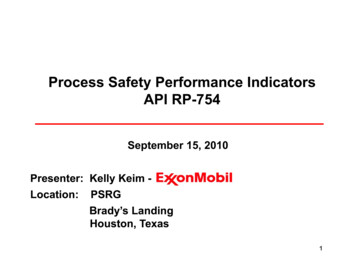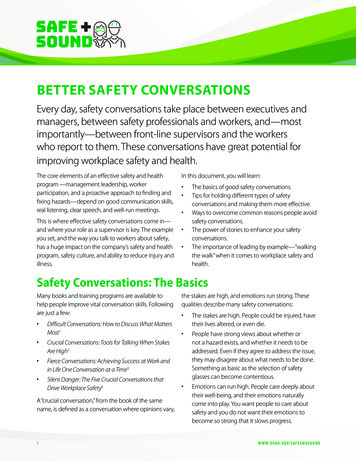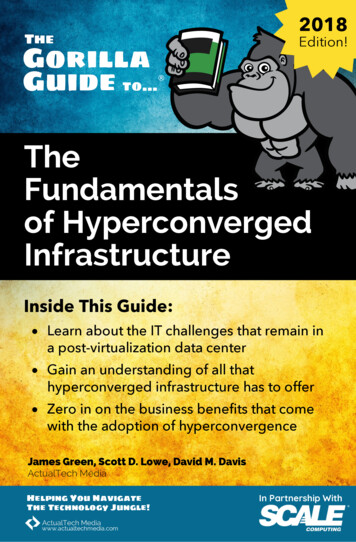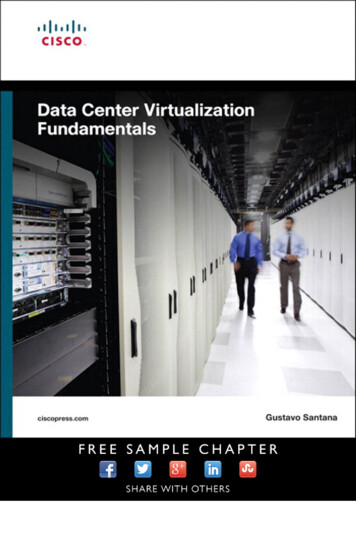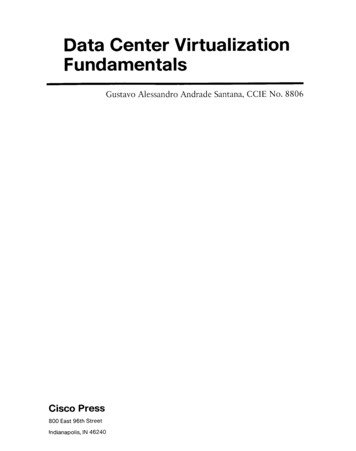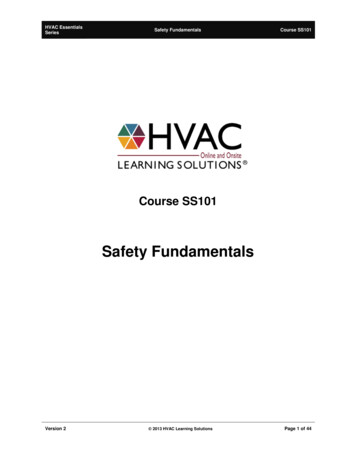
Transcription
HVAC EssentialsSeriesSafety FundamentalsCourse SS101 Course SS101Safety FundamentalsVersion 2 2013 HVAC Learning SolutionsPage 1 of 44
HVAC EssentialsSeriesSafety FundamentalsCourse SS101Note:This manual contains the 5S tag system that is designed to make you aware of the hazards that may bepresent during the course of the task. Safety is our first priority. You will see 5S tags throughout the bookindicating any safety information and equipment required. The purpose of the 5S system is to make youaware of any hazards that are present and that may cause injury. With the information presented prior tothe task, you will develop good quality job habits that will ensure safety is followed. With proper safetyequipment and awareness of the hazards you will complete your task safely and efficiently.Safety TagsInformation regarding the subject will appear in red text, boxed in, with safety information, hazards, andsafety equipment. The 5S safety tags will give you the information you need to use safe practices in thattask. As you continue the training you will learn the proper practice for safety at each level of the job.Version 2 2013 HVAC Learning SolutionsPage 2 of 44
HVAC EssentialsSeriesSafety FundamentalsCourse SS101Table of Contents1.Personal Safety . 51.1.1.2.1.3.1.4.1.5.1.6.1.7.1.8.1.9.Common Sense Is a Very Important Part of Safety . 5Personal Attitude toward Safety . 6Personal Protection . 6Eye Protection . 7Back Protection . 8Head Protection . 9Hearing Protection . 10Lung Protection . 10Hand and Foot Protection . 112.Review Questions – Personal Safety. 143.Emergency Medical First Aid . 163.1.3.2.3.3.3.4.Eyes . 16Cuts . 17Heat Exhaustion . 18CPR and the Handling of Choking Victims . 194.Review Questions - Emergency Medical First Aid . 205.Electrical Safety . 225.1.5.2.5.3.5.4.5.5.5.6.5.7.Voltage . 23First Response for Electrical Shock Victims . 23Seven Rules for Safe Practice and to Avoid Electric Shock . 24Working with Energized Circuits . 25Tools . 26Extension Cords . 27Lockout Tags . 286.Review Questions - Electrical Safety. 307.Equipment Safety . 337.1.7.2.7.3.Ladders . 33Material Safety Data Sheets (MSDS) . 34Welding, Cutting, and Brazing . 358.Review Questions - Equipment Safety . 379.Fire Safety . 399.1.9.2.Version 2Fire Extinguisher Classifications . 40Using a Fire Extinguisher to Put Out a Fire . 40 2013 HVAC Learning SolutionsPage 3 of 44
HVAC EssentialsSeriesSafety FundamentalsCourse SS10110. Review Questions – Fire Safety . 4211. Conclusion. 44Version 2 2013 HVAC Learning SolutionsPage 4 of 44
HVAC EssentialsSeries1. Personal SafetySafety FundamentalsCourse SS101Safety Equipment RequiredWorking on HVAC equipment demands several skills. A technician must be able to work withelectricity, hand tools, and test equipment. Air conditioners also present the following hazards. High-pressures High temperatures Extremely low temperatures High voltage High electrical current Moving partsSafety Equipment RequiredAwareness of all electrical components and connections and moving parts. Lock out tags, safety glasses,thermal gloves, Volt meter, refrigerant gauges and several hand tools needed to complete these jobs.Safety rules for employeesProvide the following tips to your employees to help them avoid injury and protect you bottom line: Wear the right clothing for the job. Winter cold and summer heat can present problems on the job.Shirts should be worn at all times. Wear appropriate safety shoes for the job. Use the right personal protective gear, including safety glasses, hard hats, and safety shoes. Never wear rings, necklaces, and other jewelry if it can pose a hazard. Be aware that open flames or sparks can ignite combustible materials. Portable heating and weldingequipment, along with discarded cigarette butts, pose the greatest dangers. Participating in horseplay is dangerous and counterproductive. Avoid it!1.1.Common Sense Is a Very Important Part of SafetyAwareness is also a key ingredient. A good technician will always pay close attention to hissurroundings. Many accidents are caused by carelessness, which may result from:Version 2 2013 HVAC Learning SolutionsPage 5 of 44
HVAC EssentialsSeries Rushing through the job Working when tired Not following basic safety rules Improper trainingSafety FundamentalsCourse SS101Most accidents can be prevented if safety is taken seriously at all times.1.2.Personal Attitude toward SafetyStatistics tell us that accidents happening in or around the workplace cause approximately 10,000 deathsper year. Always remember that you can prevent an accident by thinking ahead. You must make safety astandard that you follow every moment of the workday. While all of us enjoy having fun while we work,there is no room for horseplay in the workplace.1.3.Personal ProtectionEveryone in the technical field knows that wearing protective gear will prevent injuries. In spite of that,many people have chosen not to wear protective equipment. This results in many injuries and even deathsevery year!Take a moment to think about some of the consequences of an accident or injury. Lost time at work Lost income Higher insurance premiumsNot only do the employees suffer, but their families do as well.By using the methods described in the following pages, the technician can minimize accidents andinjuries and enjoy a rewarding career.Version 2 2013 HVAC Learning SolutionsPage 6 of 44
HVAC EssentialsSeries1.4.Eye ProtectionSafety FundamentalsCourse SS101Proper Safety EquipmentCertainly one of the most important safety concerns a technician should have is protecting the eyesagainst impact from debris and chemicals. While working on equipment, whether balancing a refrigerantcharge, adjusting gas pressure, drilling, or brazing, always wear the safety glasses that are approved forthe specific task you are performing.OSHA (the Occupational Safety & Health Administration) requires the use of the following safetyglasses. Chemical Protective Goggles must be worn when working withrefrigerants. The goggles must be splash proof. Wrap-around safety glasses must be worn when servicingequipment and using tools. Both types must meet ANSI (the American National StandardsInstitute) standard Z87.1.While regular eyeglasses with safety lenses can be worn, you must use side shields to protect againstdebris impact. It is still better to wear safety glasses over regular eyeglasses to avoid damaging expensiveprescription eyewear. Both safety goggles and wrap around glasses are inexpensive and available at mostsupply houses.Proper Safety EquipmentWear proper protection equipment for each task that calls for it. Safety glasses are an important piecewhen your eyes may be in danger of flying debris or chemicals. Safety glasses protect your eyes whileworking in a safety hazard job task. Safety glasses are made of shatter-resistant plastic side shield willprotect your eyes from splashing and flying debris. Regular glasses cannot function as safety glasses.Version 2 2013 HVAC Learning SolutionsPage 7 of 44
HVAC EssentialsSeries1.5.Safety FundamentalsBack ProtectionCourse SS101Proper Lifting TechniqueThe leading injury in the work place usually has to do with injuries to the back. While most back injuriesare minor, there can be severe damage that can result in permanent injury.Here are some tips that can help reduce the possibility of backinjury. While working on a system that causes your body to bearched, crouched or stooped, it is best to take frequentbreaks. Stand up and stretch your body forward andbackwards and side to side. Never lift or carry anything that is beyond your limits. Getsomeone to help.Proper Lifting TechniqueBend to lift an object – don’t stoop. Keep your back straight by tucking in your chin. Lift with the strongleg muscles, not the weaker back muscles.1.5.1.Lifting MaterialsTo lift materials properly:1) Bend at the knees.2) Keep your back straight.3) Keep your body square with the object and your legs apart with onefoot positioned slightly forward.4) Get as close to the object as possible.5) Concentrate on tightening the stomach muscles.6) Let your leg muscles do the work of lifting the object.1.5.2.Handing the LoadNow that you are standing up straight, here are a few things to remember about handling the load.1) When turning, pivot your body by using your feet, keeping the back straight.Version 2 2013 HVAC Learning SolutionsPage 8 of 44
HVAC EssentialsSeriesSafety FundamentalsCourse SS1012) Carry the load as close to the body as possible.3) Walk at a slower pace.Once you have made it to the destination, remain as straight as possible and reverse the procedure forlifting.Back support belts have been used successfully in the industry for several years. It has been proven thatwearing these belts has reduced the number of back injuries dramatically. It is recommended anytimeyou are lifting material in excess of 10-15 pounds, you should wear a back support belt.1.6.Head ProtectionProper Safety EquipmentWhen working in an environment where falling objects are a possibility, you should wear a hard hat.Head injuries can be life threatening! While many residential technicians, as well as parts personnel, havethe opinion that only commercial sites present a hazard, this should be reconsidered. It is definitely betterto be safe than sorry.Hard hats come in many types depending on the work environment.Plastic, composite, and metal are among the materials used. The wearingof a hard hat is strictly to prevent all types of head injuries.Note: Never wear a metal hard hat when working on electricalcomponents. Drilling holes or otherwise modifying a hard hat can make it unsafe! Do not attempt to modify a piece of protective equipment!Proper Safety EquipmentYou must protect the head if you are in a hazard of objects falling from above and striking you on thehead. That you might bump your head against a fixed object such as exposed pipes or beams. They aredesigned to resist penetration by objects, absorb shocks and blows, water resistant and slow burning.Version 2 2013 HVAC Learning SolutionsPage 9 of 44
HVAC EssentialsSeries1.7.Safety FundamentalsHearing ProtectionCourse SS101Proper Safety EquipmentHave you ever wondered what it would be like to lose yourhearing or eyesight? It would be difficult, if not impossible,to continue doing your job. Using protective equipmentwill help assure this won't happen.Some of the situations requiring hearing protection include: Using a skill saw, reciprocating saw, or high speed drill. Using high-pressure air tools. Being exposed to moderate levels of noise for an extendedperiod of time.The two types of protection generally used are earplugs andearmuffs. Headphones designed for use with a radio are notsuitable for hearing protection.Proper Safety EquipmentHearing protection is important because you ears are composed of very delicate structures. Whenever asound produces air is set into motion as sound waves. If the wave enters the era with high pressuredamage to the structure of the ear can result.1.8.Lung ProtectionProper Safety EquipmentThe purpose of our lungs is to deliver the proper amount of oxygen to the blood
HVAC Essentials Series Safety Fundamentals Course SS101 Version 2 2013 HVAC Learning Solutions Page 5 of 44 1. Personal Safety Safety Equipment Required Working on HVAC equipment demands several skills. A technician must be able to work with electricity, hand tools, and test equipment. Air conditioners also present the following hazards.





